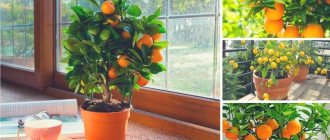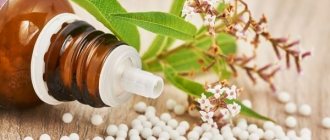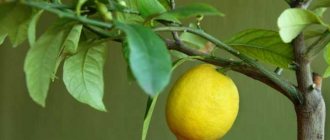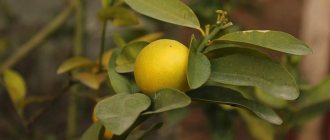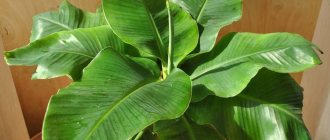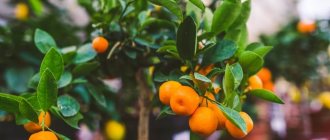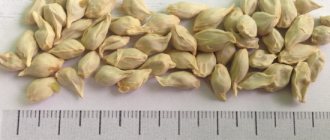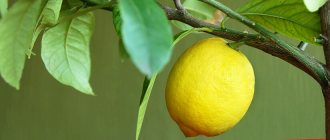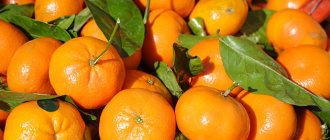Isn’t it tempting to admire the snow-white stars of tropical flowers on your windowsill, drink tea with golden lemon just plucked from a branch, or add home-grown fragrant kumquats to your homemade jam? But all this is real!
Of course, citrus fruits will not become tall, spreading trees at home, but in a small winter garden, or even in an apartment, it is quite possible to grow a healthy, regularly flowering and fruiting, and simply very beautiful plant from a seed.
Types of domestic citrus fruits
The best producers have filled the market with all sorts of popular varieties of citrus fruits, which will not only decorate your home, but also fill your home with delicious fruits. What can you grow at home? The list is quite impressive:
| Kinds | Description |
| Citron (cedron, cedrate) | Compact tree. Decorated with oblong fruits of an interesting type. The taste is unusual. Pulp in limited volume. Purchased for decorative purposes. The most unique variety is considered to be “Buddha’s Hand”. The fruits look like a bunch of bananas. |
| Lemon | The most popular home variety is called “Pavlovsky.” Positive properties: • unpretentiousness; • high productivity; • attractive appearance. You can decorate your house with the Lunario variety. Looks attractive. The fruits are small. If you give preference to aromatic fruits, then experts recommend choosing the “Kursky” and “Novogruzinsky” varieties. |
| Lime | Belongs to the category of new products. A distinctive feature from lemon is more pronounced acidity and the absence of seeds. They end in green. After short storage, the peel becomes yellowish. You can often find hybrids called Limequats on windowsills. |
| Mandarin | They are resistant to low temperatures. The maximum permissible height of a houseplant is one and a half meters. With proper care, you can harvest a wonderful harvest - up to hundreds of pieces. |
| Orange | In nature, the tree reaches a height of 20 meters. You cannot grow such a specimen in an apartment. The breeders did not fall flat on their faces and created a unique dwarf that fits on the windowsill. Flowering occurs in March. After 9 months, fruiting begins. |
| Kumquat | It is extremely popular. Easy to care for. It grows from a seed that even a child can plant. The fruits have a pleasant taste. Which manufacturer is better to buy depends on personal preferences. |
| Pomelo | Evergreen tree. The fruits are large, each weighing up to 10 kg. The peel is green or yellow. The slices are covered with an inedible film. Fruiting duration is up to 7 months. Citrus is very popular due to the presence of beneficial substances. Doctors recommend using it for heart problems. By regularly eating fruits, the risk of developing diabetes is reduced to zero. Pomelo helps strengthen the immune system and accelerates metabolism. This exotic fruit looks great at home. It is grown from the seeds (seeds) of the fruit. There are special requirements for planting material. You need to choose the right starting fruit. It should be: • with a citrus tint; • pleasant aroma; • have good density; • don't seem empty; • have smooth, dense and soft skin; • complete absence of stains and rot. |
Growing Tips
Most citrus fruits can be propagated by grafting, cuttings or seeds. A regular bone is considered the best option. At first, a weak sprout sprouts, from which over time a large tree or bush will grow. Getting a sprout from a seed is just the beginning of the journey. To enjoy tasty and healthy fruits, you will have to wait from 7 to 15 years, depending on the type and variety. To speed up the process of citrus fruit emergence, it is necessary to vaccinate. Experts advise using cuttings from trees that have already entered the fruiting stage for these purposes.
The size of the bush may vary. Considering the height of the ceilings in your home, office or educational institution, it is worth purchasing dwarf seedlings that will not rest against the ceiling, even when standing on the floor.
There are two main methods of reproduction: seeds and shoots. Let's look at each type in more detail.
- Planting material – seeds. It is intended to use freshly collected specimens from high-quality fruit. The planting depth should be maintained, which should not exceed 3 centimeters. The maximum pot is 2 liters. A prerequisite is the presence of a drainage hole in the bottom. The bottom of the container is filled with drainage. Next is a special substrate for citrus fruits. After placing the grain in the soil, the pot is covered with glass or film. Thanks to the creation of greenhouse conditions, seedlings will appear quite quickly. Some seeds will hatch in a week, others require a longer period - up to 2 months. When several sprouts appear from one seed, it is necessary to leave one, the strongest and strongest.
- Through cuttings. The starting material is apical cuttings. They are placed in wet river sand at a slight angle. A plastic bottle is placed on top. The ideal temperature is from 20 to 25 degrees. The planting site should be well lit, however, direct sunlight should be avoided. The roots will begin to appear after 30 days. Once the process has begun, you need to transplant the cuttings into a special soil mixture. In this case, manipulations are carried out carefully so as not to damage the young roots. This method is in high demand among flower growers, as it allows one to preserve the original characteristics of the mother plant. In this case, the process of flowering and fruiting begins much earlier than when propagated by seeds.
Hybrids
The largest range of citrus indoor plants are in the form of hybrids. The following hybrids are very popular among gardeners:
- Limetta Pursha or sweet lemon. A distinctive characteristic is the sweet citrus taste. Pursha is similar to lemon, but has more spherical fruits;
- Pomelo or Pompelmus. Although Pomelo is often considered a grapefruit hybrid, it is not one. Pomelo is considered a separate type of citrus. The Pomelo fruit has a spherical shape. This is the largest citrus. One fruit can weigh up to 10 kg. Pomelo has a sweet taste, without the bitterness characteristic of grapefruit;
- Limequat. The hybrid is obtained by crossing kumquat and lime, as the name suggests. Limequat has three varieties, which can be distinguished by their fruits. Limequat is similar in chemical composition to lime. However, Limequat is more frost-resistant than lime. Therefore, Limequat is an excellent substitute for it;
- Ponderosa. This variety was created by crossing pomelo and lime. The Ponderosa has characteristics of both parents. A characteristic feature is high resistance to high temperatures. Therefore, this hybrid perfectly withstands apartment conditions;
- Clementine. The plant is a hybrid of a tangerine and an orange;
- Orangeish. This is a hybrid of kumquat and orange;
- Calomondin. It is a hybrid of tangerine and kumquat.
In addition to them, there are other hybrid varieties. Thanks to the different combinations of different varieties, the fruits of such hybridomas have a wide variety of colors and tastes. Therefore, everyone will find the variety that best suits their taste.
As you can see, indoor citrus fruits are a large group of plants that differ from each other in both appearance and fruit. To achieve abundant fruiting and a decorative appearance from plants at home, you need to try a little.
Features of care
In order for the bush not only to delight with luxurious greenery, but also to bloom and bear fruit, it is necessary to carefully care for it. Natural growth conditions are of paramount importance. The atmosphere in the apartment needs to be as close to them as possible. What should not be overlooked, according to experts:
Permanent location of the pot
Window sills are not the most suitable candidate for placing a tree. The northern part of the room should also be excluded. It is strictly forbidden to have a microwave oven, heating radiators, or various heating devices in the immediate vicinity.
The formation of drafts should be avoided. It must be remembered that in nature citrus fruits prefer to be in the shade, so the plants will feel great in the area of the western or eastern window. You can find a “shelter” not far from the southern window sill.
Citrus fruits will be grateful if they are placed on a balcony, street or open veranda in spring, summer and autumn. You just need to protect it from direct sunlight.
Indoor humidity indicator
The moisture level in the room must be maintained at maximum level. This is facilitated by regular spraying, and the water used should be at least 25 degrees. Shrubs cannot easily tolerate dry air, which negatively affects its appearance and fruiting.
Temperature
The meeting of cold and hot air in the area where the tree is located is like death. Elevated temperatures can also lead to drying out. First, the leaves fall off, and then the plant begins to “sick.” A daily temperature drop of 7-10 degrees will cause stress. The plant's dormancy period lasts from November to February. This is the period of creation of a special regime. It is worth keeping the room temperature low and avoid spraying, fertilizing and watering. Rest is a prerequisite for the healthy state of a handsome pet.
Choosing the right soil
It is not recommended to plant the plant in ordinary soil. Special substrates have been created for these purposes. They provide full development. The necessary soil mixture can be purchased at specialized retail outlets for gardeners. There, a professional seller will help you with your choice and instruct you. You can order goods online in the online store. The price will be better, however, no one will be responsible for the quality of the delivered soil.
Pot parameters
How to choose the right option? It is worth giving preference to unglazed fired clay. Wooden construction is also suitable. Pay attention to the presence of drainage holes. They must be present without fail. A sufficient amount of drainage layer is placed at the bottom of the tank.
Watering rules
Tap water is not suitable for irrigation. It contains many negative impurities such as chlorine. Plants cannot tolerate it and may wither. The temperature of the irrigation liquid is set at 20 - 22 degrees. The water is first settled and then acidified. Just add a few drops of vinegar.
Feeding
This issue is given special attention. The time to apply fertilizer is from February to November. Manipulations are carried out regularly. Organic and mineral compounds are used, including phosphorus, potassium, and nitrogen. The organic matter is settled slurry, which does not have an unpleasant “aroma”. Before watering, it must be diluted with settled water in a ratio of 1 to 10. The solution is applied twice during the entire period: the first in early spring, the second in mid-summer.
It is better to choose potassium nitrate from mineral fertilizers. It is diluted with water 1 to 10. Ammonium nitrate should not be neglected. The benefit from it is significant if you maintain the dose - 30 grams of the composition per 10 liters of water, and then dilute the resulting mixture with water in a ratio of 1 to 10. Feeding is carried out once or twice during the month. Much depends on the condition of the pet.
Illumination
It is worth noting that in their natural habitat, citrus fruits grow with long daylight hours throughout the year. If in summer the trees have enough light, then in winter they lack it. It is necessary to increase daylight hours through the use of special phytolamps. They will lengthen the day to 12 hours, which will have a positive effect on the growth and development of the plant.
Graft
It is carried out in two ways: copulation and budding. The rootstock, as well as the scion, can be from different plant species. For the rootstock, the best option would be lemon, grapefruit or orange.
Transfer
Replanting a tree leads to stress. It then gets very sick. Therefore, manipulations must be done with all seriousness and very carefully. The plant just waddles over. Under no circumstances should you wash the root system or completely replace the soil.
Pests and diseases
Shrubs growing at home are most affected by spider mites, aphids, mealyworms and scale insects. The most common diseases are considered to be warts, anthracnose, and gommosis. Treatment of the disease takes a long time and is not always successful, so it is better to prevent the onset of the disease. As soon as the first symptoms are identified, it is necessary to take active action:
- the affected leaves are promptly removed;
- the plant is freed from painful fruits and buds.
Home beauty should focus all its efforts on restoring health and attractive appearance. Damaged elements cannot be saved, but the remaining parts can be maintained healthy.
The main reason for the appearance of the disease is improper care and conditions created. If you care for them according to the rules, strictly follow the requirements and recommendations of experts in this field, and pay maximum attention to your green pets, then danger can be avoided.
Conditions for indoor cultivation of citrus fruits
As with all potted citrus plants grown indoors, the important conditions are:
- lighting
- temperature
- humidity
- the soil
Lighting and temperature
Like all plants from tropical and subtropical climates, citrus fruits require light. To grow them, it is best to choose windows oriented to the south, southwest, southeast. In cases where this is not possible, a pot with a citrus plant can be placed near any window with additional lighting.
For this, one fluorescent lamp is enough. In addition, among these crops there are also shade-tolerant ones. Like lighting, temperature conditions are very important for citrus crops. Moreover, the summer regime differs from the winter one.
Starting in spring, pots of citrus fruits should be kept in a room where the temperature does not drop below + 18. This will promote the formation of buds and the beginning of flowering. In winter, most citrus fruits should be grown at + 12 degrees. Tangerines can be kept at this time of year even at + 8. If seasonality in temperature conditions is not observed, then you may not wait for the formation of buds and full flowering.
Humidity and watering
The optimal humidity for most citrus fruits should be maintained at least 60%. On hot summer days, as well as in winter. with hot radiators, citrus fruits should be sprayed with warm water at least once a day. These plants respond well to a warm shower.
Plants need to be watered as the soil in the pots dries 1/3. In winter, watering is quite rare; you can water citrus fruits once every 3-4 weeks, but without waiting for the soil in the pot to completely dry out. Since all citrus fruits are long-lived, the soil in the pot is suitable for growing them.
The soil
To fill the pot for citrus potted crops, you can purchase a ready-made mixture for these crops. If this is not possible, then you can prepare the soil yourself. For younger plants, the following composition is suitable:
- coarse sand or the finest gravel - 1 part
- well-rotted manure - 1 part
- earth, leaf, - 1 part
- earth, turf, - 2 parts
If the soil is needed for transplanting and growing an adult plant, over 5 years old, then a soil composition will be suitable in which there will be three parts of turf soil, and one part of all other components.
Rating of quality lemon seedlings
Pavlovsky
A one-year-old seedling is usually 15 centimeters high. The first branches and leaves appeared from the cuttings. The root system is just beginning to develop. Vaccinations and careful care are not required. Avoid drying out the soil and exposing it to direct sunlight. Fruiting occurs in the third year of life. There is a lot of ovary. The fruits are tasty and healthy. The variety was bred in the 19th century. Afterwards there were many years of adaptation to new Russian conditions. Pavlovsk lemons symbolize love and prosperity. Used in cosmetology and medicine.
In appearance it resembles a bush or tree. The maximum height is one and a half meters. Crown - branches with thorns. The leaves are oval-shaped, tapering towards the edge, up to 15 cm long and up to 8 cm wide. The leaves are renewed every two to three years. Trunk with brown bark. The flowers are large. They can grow either singly or in pairs. The question of how to pollinate is not worth it. The plant is self-pollinating.
The fruits are spherical and round. The skin is found smooth and rough, thickness from 2 to 8 mm. Slices from 8 to 12 pieces. They are separated by a film and filled with juice. The taste is sour. The minimum weight of a lemon is 120 grams.
The average price of goods is 600 rubles.
Advantages:
- benefits the lungs;
- purifies indoor air;
- improves well-being;
- causes cheerfulness;
- can be grown both at home and in the office;
- a storehouse of vitamins (B2, B1, D, P, C);
- inexpensive;
- self-pollinating;
- treats viral infections;
- normalizes the nervous system;
- cleanses the intestines;
- heals cracks in the skin.
Flaws:
- not identified.
Lemon Meyerra
A one-year-old citrus plant can be purchased at an affordable price. A time-tested variety. Regardless of growing conditions, it produces a large harvest. The aroma when flowering is unsurpassed. The smell of the leaves is not so much lemon as orange. The fruits are bright yellow in color. The pulp is orange and unnatural. The juiciness is at its best. It surprises with its tart aftertaste. It is extremely popular not only in our country, but also abroad. Often found in the USA and China.
The second name is Chinese dwarf. A hybrid of lemon and orange, created by nature itself in natural conditions. The variety is intended for home decoration and industrial cultivation. It is unpretentious to climatic conditions. The yield is impressive.
The smallest of his brothers. It grows in height up to one and a half meters. The leaves are pointed, oval, smooth, dark. The fruits are bright, modest in size. Appear in the third year of life. The ripening period is 9 months from the moment the ovary appears. Its presence will decorate any interior. How often does it bear fruit? All year round. Peak flowering occurs in spring. In one season you can harvest up to 3 kg of crop. The average weight of one lemon is 150 grams. The skin is thin. The pulp is orange, sweet and sour, with a slight bitterness.
The purchase price is 600 rubles.
Advantages:
- remontant variety;
- not afraid of difficult climatic conditions;
- frost resistance;
- unique decorative characteristics;
- abundance of vitamins;
- supports the immune system;
- used to prevent colds;
- lifts the mood.
Flaws:
- not found.
Panderosa
The fruits are huge in size, sometimes reaching 1 kg. A distinctive feature of the variety is its unpretentiousness. Even in a dark, dry room it will grow and develop safely, bloom and bear fruit. You can form a crown of any type. Flowering is abundant and frequent.
There are few lemons. The average weight of each is at least 250 grams. Maturing period is 10 months. The bush is low and compact. The leaves are dark green. Used as a home doctor.
It is a hybrid of grapefruit and citron. Until now, his appearance is a mystery. There are two official versions of the miracle:
- the result of natural crossing of citrus fruits belonging to different groups;
- American breeders had a hand.
Some consider the species to be a variety of dwarf pomelo.
The average price is 600 rubles.
Advantages:
- antiparasitic and choleretic agent;
- the presence of flavonoids and antioxidants in the peel;
- a large amount of vitamins;
- disinfects the air;
- used in cooking as a spice;
- application in cosmetology.
Flaws:
- none.
Novogruzinsky
It grows large in size, so it is not suitable for tiny spaces. Flowering occurs in the 4th year of life. Fruiting is abundant. Looks perfect in a spacious room with high ceilings. Planted in a medium pot, which can be placed both on the floor and on the windowsill. If the tree is not trimmed, it will grow more than two meters. The formation of a crown is not only desirable, but also mandatory.
The branches are spreading and strong. The leaves are elongated, light green, with a unique lemon aroma. The bark is green, which makes the bush more elegant. The variety is classified as remontant. The fruits are medium, from 120 to 170 grams. The shape resembles an elongated oval. The skin is light yellow, oily, smooth. The taste of lemon is sour but pleasant. The pulp is juicy.
A seedling in a nursery sells for 600 rubles.
Advantages:
- tolerates transportation well;
- long shelf life;
- unique taste and aroma;
- high productivity;
- standard care;
- the fruits are suitable for making refreshing drinks;
- value for money.
Flaws:
- not installed.
Which citrus fruits are suitable for growing in pots?
Not only in Asian countries, but also in countries with cold climates, the tradition of growing indoor citrus fruits goes back several hundred years. Growing lemons is especially popular.
Indoor varieties of lemons
If you plant a lemon seed in the ground, it will definitely sprout. Sooner or later the sprout will turn into a fairly large tree, but most likely there will be no fruit on it. Special, indoor varieties of lemons are most suitable for growing in pots:
- Pavlovsky is a popular self-pollinating indoor variety with trees 1.0 to 2.0 m high, fragrant flowers, large fruits
- Novogruzinsky - trees up to 1.5 m high, large flowers, flowering begins at the age of four years, produces fruits weighing up to 120 grams
- Maikop - a variety obtained as a result of folk selection, bears fruit abundantly, lives long
- Genoa - low trees, without sharp shoots, produces up to 50 fruits in the fifth year
The choice of varieties of indoor lemons is very large, which confirms the popularity of these plants among lovers of indoor floriculture. The assortment of other citrus fruits is somewhat more modest, but there is still a huge selection here.
Tangerines
Among all citrus fruits, tangerines are the easiest to tolerate low temperatures; the following varieties of tangerines are suitable for growing indoors:
- forged - Vasya - in indoor conditions, trees are no higher than 1 m, bloom and bear fruit from the second year
- Sochi 23 - fruits are bright, orange, slightly flattened, weighing up to 80 grams
- clementine - a hybrid of orange wren and tangerine
Oranges
Orange varieties for growing in pots:
- Gamplin - dwarf plants no higher than 1.5 m, one of the best and most productive indoor oranges
- Pear-shaped kinglet - a popular orange with pear-shaped fruits
- Pavlovsky - the best indoor variety
- Adjarian seedless - fruits are bright, flat-round
In addition to the above citrus fruits, you can grow kumquat and its hybrids at home:
- calomondin - a hybrid with mandarin
- orangish - with orange
- limequat - with lime
Bitter oranges, grapefruits, and various hybrids also grow at home. Despite the fact that this list is far from complete, all citrus indoor crops require certain conditions.
Rating of the best orange seedlings
Navelina
An interesting variety of citrus fruits. It differs in appearance from its counterparts. The fruits are pear-shaped and very tasty. The juiciness is impressive. Seeds are completely absent. The pulp is aromatic. It is in high demand among domestic flower growers. Fruit ripening occurs at an early age. Oranges are distinguished by their sweetness and excellent taste characteristics. You can detect a slight sourness. Tolerates any climatic conditions. However, it is not advisable to transport over long distances.
The tree belongs to the category of medium-sized. The crown is dense and wide. The leaves are elliptical in shape. The fruits are small, weighing up to 250 grams. Depending on the time of year, the shape of the oranges may change. There are no seeds. The leaves are dense, with sharp tips. Citrus is able to solve the following important problems:
- remove slagging from the intestines;
- eliminate stress;
- improve heart function;
- strengthen the walls of blood vessels;
- remove toxins and free radicals from the human body;
- minimizes the possibility of cancer cells appearing;
- restores the functioning of the digestive system;
- improves vision;
- restores damaged tissues;
- has bactericidal properties;
- improves blood quality;
- lowers cholesterol levels;
- increases endurance;
- allows you to lose excess weight.
The average cost of a 1-year-old seedling is 800 rubles.
Advantages:
- a lot of useful qualities;
- the presence of a large amount of minerals and vitamins;
- low calorie content;
- included in the diet;
- helps men restore prostate function;
- prolongs youth for women;
- the possibility of using the pulp to make ice cream.
Flaws:
- none.
Washington Navel
Two-year-old seedling. The variety is early ripening. The fruits are large, seedless. An ideal indoor unpretentious citrus fruit. Easily tolerates unfavorable climatic conditions. The taste of the fruit remains unchanged. Oranges are very beneficial for the body. Quite large, elongated in shape, rich bright color. The zest is rough, of medium thickness. The pulp is dense and aromatic. The crown is rounded. Plant height is average.
During the flowering process, it is necessary to create favorable conditions for your pet. Excessively high temperatures and dry air should not be allowed. Otherwise, it does not require special care. For full growth and development, it is enough to maintain the correct temperature, monitor humidity, avoid direct sunlight, water and feed in a timely manner. Poultry droppings (a weakly concentrated solution) and rotted mullein are suitable as fertilizers. Substances infused in water are diluted at the rate of 1 to 20. After filtering, they are added to the root.
Retailers offer the product at a price of 1,600 rubles.
Advantages:
- unique beneficial properties;
- versatility;
- use in medicine, food industry, cosmetology;
- low calorie content of the product;
- able to reduce the risk of vitamin deficiency;
- Both pulp and zest are used, as well as leaves.
Flaws:
- cannot be used if you have an individual intolerance.
Gamlin
A seedling that is one year old can be purchased at an affordable price. The variety is very popular among those who like to decorate the house with evergreens. There is no such thing as being tall. The crown is beautiful, lush, bright green. Used as decoration and for industrial purposes. The flowers are white, fragrant. Productivity is high. The fruits are tasty, juicy, sweet. A slight sourness is felt.
The sizes are average, weight is about 300 grams. Ripening time is November. The shape is round, with slight flattening on both sides. The pulp is fine-grained. There are no bones. The peel is orange, thickened. There is no shine on the surface. Easily and simply separates from the pulp without damaging its integrity.
Requires special care and constant attention to oneself. It is necessary to water every day during the summer. In another period - as the soil dries out. Spraying is carried out regularly. Early spring is chosen for feeding. Organic and mineral fertilizers are applied. It is necessary to carry out constant processing to avoid the appearance of diseases and pests.
Purchase price – 850 rubles.
Advantages:
- attractive appearance;
- purifies indoor air;
- taste qualities of fruits;
- productivity;
- storage duration;
- can be transported over long distances.
Flaws:
- not found.
Caring for citrus fruits indoors
Feeding
You should start feeding the plants in the spring. This is especially important for mature fruiting plants. The first two or three feedings with a difference of 14 days should be organic, and all subsequent ones should be mineral. For organic fertilizing, you can use ready-made vermicompost. For mineral fertilizing, a complex mixture for indoor flowers is suitable.
Transfer
As the pot develops, the plant needs to be transplanted into a larger container. The best time to transplant is the end of winter or the beginning of spring. Young plants are simply transferred to a new pot. Important! You should not replant a plant with flowers and fruits.
It is difficult to transplant large, mature plants from large tubs, but to renew the soil, you need to remove about 1/4 of the soil from above and replace it with new one.
Rating of the best tangerine seedlings
Kovano Vasya
A variety with sweetish pulp can be grown at home. The harvest is harvested twice a year. There are no seeds. The taste is sweet and sour. It is distinguished by a large presence of useful components that will prolong youth and maintain health for many years. The tree reaches a height of 80 centimeters. The foliage is light green. The crown is wide, spherical. The color of the trunk is brown, there is roughness on the bark. There are no thorns on the branches. The flowers are snow-white, a yellowish tint is very rare.
Fruiting begins in the second (third) year of life. The berries are round, with an orange skin. Up to 100 pieces appear on one tree. Ripening occurs 5 months after ovary. The lobules are identical, separated by a thin film. Despite the presence of sugar in citrus, the product belongs to the low-calorie category. A universal dietary fruit. Helps you lose extra pounds or gain the missing ones. It all depends on the time of eating (before or after meals). The composition contains useful components such as vitamins K, A, C and D. The peel contains 2% essential oil.
The average cost is 1600 rubles.
Advantages:
- expanded scope of use;
- ideal vitamin composition;
- component for traditional medicine;
- retains its original properties for a long time;
- transportability.
Flaws:
- not identified.
Satsuma
Belongs to the genus of citrus fruits. A distinctive feature is its thin skin, which is easy to clean. The core is soft, yellow-orange in color. Flowering occurs in May. There are no thorns on the branches. The pulp is juicy and tasty. The bush is cold-resistant and hardy to the vicissitudes of the weather. The maximum height of a houseplant is one and a half meters. The crown is spreading, dense, and needs regular shaping. The branches are slightly drooping. There are a lot of citrus fruits. They contain fiber, dietary fiber, carbohydrates, proteins and fats, and many vitamins and minerals. With regular use, you can restore vision, stimulate digestive activity, improve the nervous system, and improve blood pressure.
The purchase price is 1600 rubles.
Advantages:
- richness of vitamins and minerals;
- has a positive effect on the overall health of a person;
- looks attractive;
- standard care;
- perfect gift.
Flaws:
- none.
Unshiu
Japanese variety. Flowering begins in May and is accompanied by a charming aroma. The time for fruit ripening is autumn. There are no bones. The crown is dark green and requires regular pruning. The plant is unpretentious. Withstands temperatures down to +10 degrees. Can create a unique atmosphere in your home. The maximum height is 1.5 meters. The crown is spreading, the leaves are wide. Young branches are green. At two years they turn light brown. Fruiting begins at three years of age. The fruit reaches a weight of 100 grams. The pulp is pleasant to the taste, there are no seeds.
The usefulness lies in the presence of natural vitamins, antioxidants, and mineral components. They have a positive effect on the entire body as a whole. The pulp is used for vitamin deficiency, problems with digestion and the gastrointestinal tract, nervous system disorders, and high blood pressure. The dried peel is added to tea. Helps relieve pain and restores intestinal microflora.
You can purchase a two-year-old seedling for 1,600 rubles.
Advantages:
- a storehouse of vitamins and minerals;
- positive effect on the human body;
- can be bought at a nursery or ordered online from an online store;
- resistance to cold;
- does not require careful care.
Flaws:
- not installed.
Properties of citrus plants
All citrus plants are evergreen - their leaves are a storehouse of nutrients for plants during the winter dormancy period. Therefore, a sure indicator of citrus health is a large number of fresh leaves. The change of leaves on citrus fruits occurs gradually. As for the roots, they lack the suction root hairs that most plants have. Instead of hairs, mycorrhizae are formed at the ends of their thin roots - thickenings from filaments of soil fungi that transfer nutrients from the soil to the plant. But in conditions of poor water and air permeability, as well as at temperatures below -5 and above 50 ºC, mycorrhizae die. Citrus flower buds form throughout the year, but the most active flowering period is, as usual, in the spring. Citrus flowers have a delicate aroma reminiscent of jasmine or white acacia.
Indoor citruses
Citruses are members of the Pomeranaceae family; they can be either trees or shrubs; their historical homeland is the tropics of southeast Asia. In the wild, the height of some of them reaches 10-11 meters, but at home, a lemon or orange, even with the most careful care, will not exceed 1.5-2 meters.
Even beginners can grow citruses at home, the main thing is to surround the crop with care
General description:
- The bark is covered with a small number of spines.
- The foliage is rich green, dense, glossy, rich in essential oils.
- Flowering twice a year, the flowers are small, white or pink, with a light, pleasant aroma.
- The fruits can set at home; their vitamin content is not inferior to those grown outdoors, but have a milder taste.
Types of citrus fruits for the home
Citrus indoor plants are quite diverse. The simplest is lemon, which can be grown from a seed. Homemade lemon will bear fruit, but you will have to wait 3-10 years (depending on the variety) before the first harvest.
Unshiu or indoor tangerine is a short tree, rarely reaching 1.5 meters in height. However, it produces a fairly rich harvest.
In addition, you can grow oranges, kumquats, and calamondin at home (citrofortunella, a hybrid of mandarin and fortunella, a small shrub up to a meter high with shiny, rich green leaves and small orange fruits). Grapefruits are also grown.
Note! Homemade citrus makes it possible to obtain a harvest, but the fruits will be smaller
Domestic citrus trees even produce harvests
Citrus diseases
The main cause of diseases in such crops is a violation of care technology, for example, abuse of watering or fertilizing. To solve the problem, fertilizer and irrigation are normalized.
Typical diseases of citrus crops:
- chlorosis,
- powdery mildew,
- various types of rot.
Fungicides are used for treatment. In case of rot, the plant can be saved by replanting it in a clean pot with fresh, dry soil mixture.
Organization of care
Growing citrus crops at home is within the capabilities of beginners; the main thing is to choose a suitable pot for the plant, mix the substrate correctly and provide good care.
Watering mode
Citrus trees and shrubs are guests from the tropics, so they need appropriate humidity. Watering is plentiful, but rare during the growing season, starting in autumn, it is greatly reduced. In winter, plants are not watered, except when the soil dries out.
Note! It is better to use soft bottled water, liquid containing lime will cause chlorosis of the leaves
Temperature, humidity
Citrus plants will thrive in warm temperatures.
In summer they require +22..+26 degrees; temporary “relocation” of pots and tubs to the balcony is allowed
Fresh air and sunlight will have a very beneficial effect on the condition of the “green pet”. In winter, it is important to reduce the temperature to +12..+15 degrees. If the room is warmer, the plant may lose its leaves and lose its decorative effect. The humidity level is up to 70%; to maintain it, the plants are sprayed with a spray bottle.
Top dressing
To fertilize indoor citrus fruits, you should use Vostok EM-1 or organic matter, for example, horse manure or chicken manure diluted with water. It should be remembered that such fertilizers smell unpleasant, so you should avoid using them in the room.
An unpretentious lemon can produce juicy fruits with minimal but regular care.
